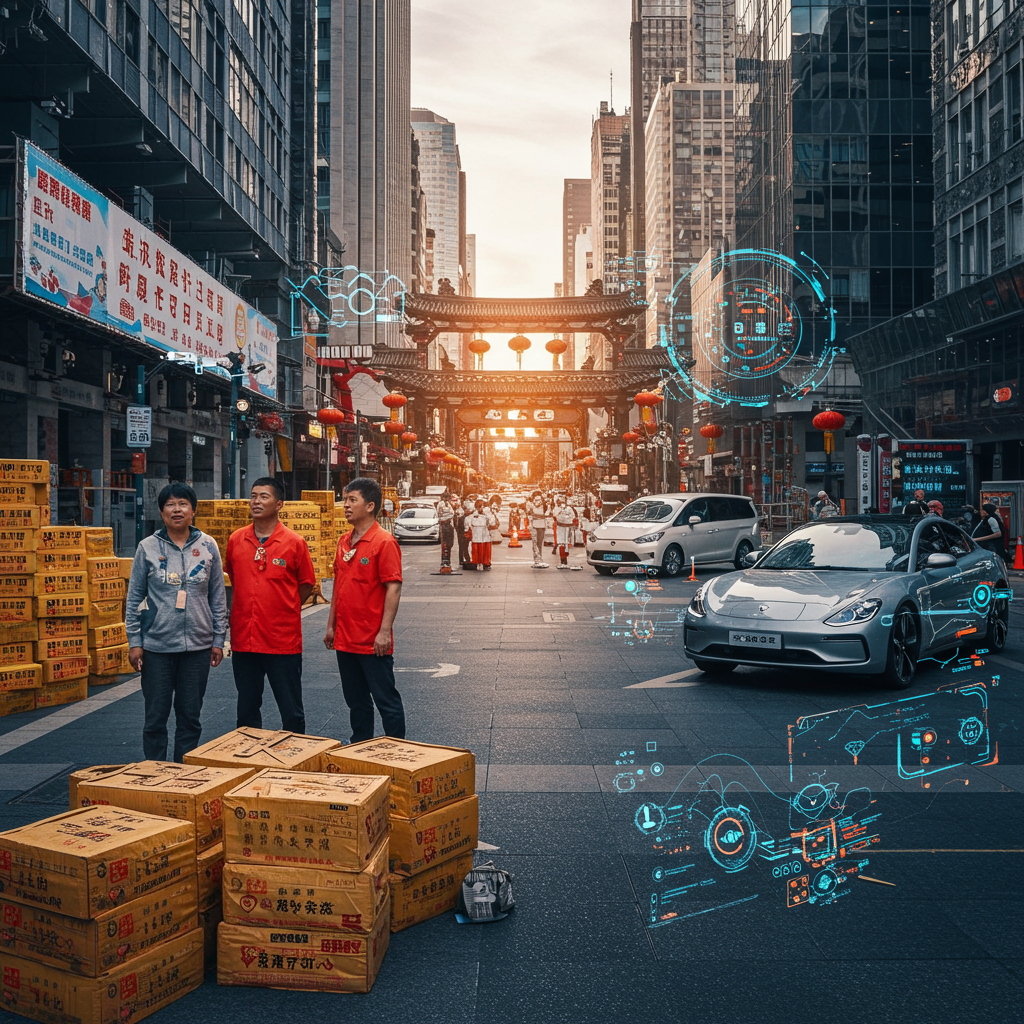china‘s economic narrative today is marked by striking contrasts, a blend of palpable slowdown in certain sectors and breakneck speed in technological advancement. On one hand, conversations with business leaders often reveal concerns over sluggish consumer demand and manufacturing contractions. Yet, almost simultaneously, discussions highlight how artificial intelligence, electric vehicles, and other cutting-edge technologies are rapidly reshaping entire industries and driving pockets of intense innovation. This duality paints a complex picture of the world’s second-largest economy navigating a challenging global landscape while simultaneously building the infrastructure for a fast-paced future. Understanding this dynamic is key to grasping China’s current trajectory.
Navigating Economic Headwinds
Recent economic data from China has certainly underscored the challenges. Official purchasing managers’ index (PMI) figures for manufacturing have shown consecutive months of contraction, signaling ongoing pressures on the industrial sector. While some alternative surveys, like one from Caixin and S&P Global, have occasionally offered glimmers of expansionary territory, the overall picture reflects a notable cooling compared to previous periods of rapid growth. The initial post-pandemic enthusiasm, which saw hopes for a robust consumption rebound, has largely faded, replaced by widespread reports of lackluster domestic spending. This difficult economic climate creates a challenging market backdrop, particularly for high-cost consumer goods.
The global trade environment also adds layers of complexity. While some reports indicate resilience in certain areas, like China’s overall export growth, particularly within the Greater China region, the broader context of international trade relations remains uncertain. The intricate dance of tariff negotiations and trade agreements, as seen in developments between the U.S. and various partners including Vietnam, Japan, and the European Union, influences supply chains and market access globally. Even within the U.S., tariffs have been noted by figures like Federal Reserve Chair Jerome Powell as influencing monetary policy decisions and inflation forecasts, indicating the far-reaching impact of these tensions on the global economic stage. For China, navigating these external pressures while stimulating internal demand is a significant balancing act.
The Acceleration of Technological Innovation
In stark contrast to the economic headwinds, China’s technological landscape is buzzing with activity. Artificial intelligence, in particular, is moving beyond theoretical discussions and becoming deeply embedded in commercial applications and manufacturing processes. This isn’t just about developing large language models; it’s about practical, industrial-scale integration.
AI Reshaping Industries from Smartphones to Mining
Consider the smartphone industry. Chinese manufacturer Honor recently showcased a new foldable phone, claiming it will be the thinnest on the market upon release. This isn’t merely a design feat; it’s a direct result of leveraging advanced AI tools in manufacturing. Honor reported using a “1-billion parameter AI industrial model” to simulate over 125,000 potential device assembly configurations. This allowed them to pinpoint the optimal balance between a slim form factor and structural integrity. Furthermore, AI-powered 3D scanning reportedly enabled manufacturing precision down to 0.003 millimeters – significantly thinner than a human hair. This level of AI-driven optimization shaves vital millimeters off device thickness, as demonstrated by the 1.1-millimeter reduction compared to their earlier foldable model launched in July 2023.
Beyond consumer electronics, AI is penetrating less obvious sectors. Huawei, known globally for its telecommunications and technology infrastructure, partnered with mining companies Yunding Technology and Shandong Energy Group to launch a dedicated AI model for commercial mining in July 2023. Based on Huawei’s foundational “Pangu” model, this technology enables remote operation of mine equipment, enhancing safety and efficiency. By March 2025, Huawei’s annual report indicated this AI tech had been integrated into over 100 mines. Further demonstrating the impact, a client in Inner Mongolia deployed 100 self-driving electric trucks in a local coal mine in May, showcasing how AI enables autonomous operations in heavy industries.
This rapid integration isn’t limited to Chinese domestic firms. German industrial giant Siemens is also actively developing AI solutions within China. Out of 18 new AI-integrated products recently launched by Siemens globally, a striking 16 were developed entirely in China within a tight nine-month timeframe. These applications include AI-powered systems designed to improve energy efficiency in buildings, illustrating China’s role as a key development hub for global tech companies.
AI Integration and Easing Tech Controls
The increasing pervasiveness of AI is a significant trend. As Janet Tang, a partner at AlixPartners, noted, AI is transitioning from isolated technological innovation into something that is “core or embedded in the whole business process.” This shift towards significant integration began roughly a year ago, following several years of trial and error. It signifies a maturation in how Chinese businesses are adopting and deploying advanced technologies.
Adding a nuanced layer to the tech landscape, there have been recent reports of the U.S. easing certain export restrictions on China for specific high-tech items. This includes curbs on chip design software and ethane shipments, indicating that while broader strategic competition persists, there might be targeted areas where commercial access is being re-evaluated. Software companies involved in electronic design automation have reportedly indicated they would resume sales to Chinese customers under these adjusted rules. This suggests the technology landscape is influenced by complex, evolving policy decisions globally.
The Rise of EVs and Other Technologies
The tech acceleration isn’t solely focused on AI. China’s electric vehicle (EV) sector continues its rapid expansion, challenging established global players. Chinese smartphone giant Xiaomi, a newcomer to the automotive world, recently entered the EV market with significant impact, launching two electric car models designed to compete directly with industry leader Tesla. The initial market reception has been notable, with reports of Xiaomi receiving over 200,000 pre-orders for one model in just minutes after its pricing was revealed. This underscores the strong domestic demand and competitive intensity within China’s EV market. Other Chinese EV manufacturers like Xpeng are also demonstrating robust delivery figures, highlighting the sector’s momentum.
Beyond EVs, augmented reality (AR) is another area seeing significant development. Startup Xreal, focused on AR glasses, is expanding its operations and relocating its headquarters from Beijing to Shanghai this summer. This move positions them closer to specialized factories in Wuxi that produce critical optical components. Xreal is investing in its own manufacturing facilities and developing new products running on Google’s XR operating system, targeting both the domestic market and the U.S., which remains their largest market.
Shifting Geographic Centers of Growth
While major Chinese metropolises have not fully returned to the pre-Covid economic boom levels, the pace of growth appears to be accelerating in smaller, second-tier cities and even rural areas. This geographical shift suggests a broadening distribution of economic activity and investment opportunities.
A compelling example is Malipo county in Yunnan province, a region that historically received targeted poverty alleviation assistance. In 2023, Malipo began revitalizing its border trading port with Vietnam, leading to a surge in cross-border commerce, notably in durian trade. Simultaneously, foreign investment is flowing into such areas; Hong Kong’s Sunwah Group committed 50 million yuan in 2023 to establish a tea processing plant in Malipo. Plans are also underway to develop tourism initiatives, leveraging the region’s agricultural heritage and natural beauty. This demonstrates how infrastructure development and targeted investment are unlocking potential in previously underdeveloped areas.
The relocation and expansion plans of companies like Xreal, moving their headquarters to Shanghai to be nearer their Wuxi factories, further illustrate the strategic importance of Tier 2 cities as manufacturing and operational hubs. These cities offer advantages that complement or even surpass those of the traditional mega-cities for specific industries requiring proximity to specialized supply chains or manufacturing capabilities.
Expert Perspectives and Market Signals
Industry experts observing the Chinese landscape echo this sense of dynamic change amidst underlying challenges. AlixPartners’ Janet Tang’s observation about the significant integration of AI into core business processes over the last year highlights the tangible shift occurring within enterprises. The energy and drive of Chinese businesses, their eagerness to learn and connect globally despite protectionism, was also noted, underscoring a fundamental resilience.
The financial markets reflect this mixed picture. While mainland Chinese and Hong Kong stocks saw modest gains amid mixed trading signals, investors continue to digest various inputs, including global economic data and geopolitical developments. Specific company news, like Xiaomi’s massive EV pre-orders or Xpeng’s consistent delivery numbers, provides positive micro-level indicators, even as macro manufacturing data shows contraction.
Investors are also increasingly looking to diversify assets beyond just the U.S. and Chinese markets, a trend reflecting the complexities and uncertainties inherent in today’s major economies. However, global businesses like IKEA (managed by Ingka Group) still see significant opportunities within China, including tapping into the growing “silver economy” demographic. Furthermore, logistics giants like DHL note the continued resilience of the region’s export growth, indicating that despite trade friction in some areas, the fundamental engine of Chinese manufacturing and export capability remains strong.
Frequently Asked Questions
What are the main signs of China’s economic slowdown mentioned in the article?
The article points to several indicators of China’s economic slowdown. These include official manufacturing PMI figures showing multiple consecutive months of contraction, reports of lackluster domestic consumption following the initial post-Covid excitement, and widespread anecdotal concerns among business counterparts regarding a sluggish economy. This suggests challenges particularly within the manufacturing sector and consumer demand.
How is artificial intelligence being applied in China beyond consumer technology?
AI in China is being integrated into heavy industries and manufacturing processes. The article provides examples like smartphone company Honor using a 1-billion parameter AI model for simulating device assembly and achieving precision in manufacturing, and Huawei developing a dedicated AI model for commercial mining, enabling remote operation of equipment and self-driving electric trucks in mines. German company Siemens is also developing AI solutions in China for applications like energy-saving building systems.
Where are new areas of growth appearing in China besides the major cities?
The article indicates that rapid growth is spreading to smaller, “tier 2” cities and even rural areas. Examples include Malipo county in Yunnan province, which is revitalizing its border port trade and attracting foreign investment for projects like a tea processing plant, alongside plans for tourism development. Augmented reality company Xreal is also investing in its factory in the Tier 2 city of Wuxi and relocating its headquarters to Shanghai partly to be closer to specialized manufacturing hubs like Wuxi.
Conclusion
China today presents a compelling paradox: an economy grappling with slowing growth and complex global trade dynamics, yet simultaneously driving forward with astonishing speed in areas like artificial intelligence, electric vehicles, and advanced manufacturing. While traditional economic engines may be sputtering, innovation is flourishing, reshaping industries and fostering new growth centers away from the well-trodden paths of major cities. This blend of challenge and technological acceleration defines China’s current position on the global stage, presenting both hurdles and opportunities for domestic and international players alike. Navigating this dual reality requires a nuanced understanding that looks beyond headline economic data to the underlying currents of technological transformation and shifting market landscapes.
Word Count Check: ~1180 words




